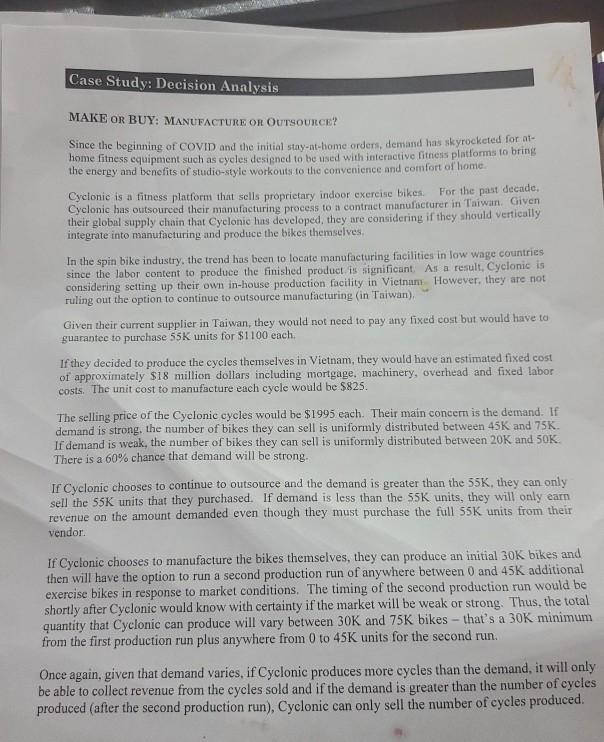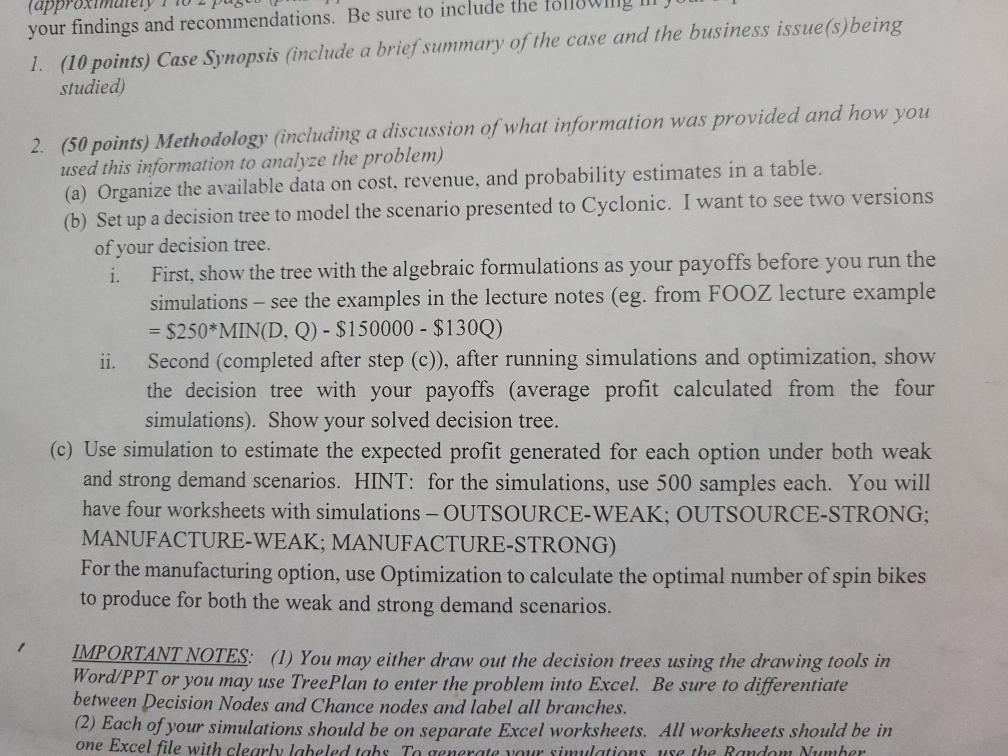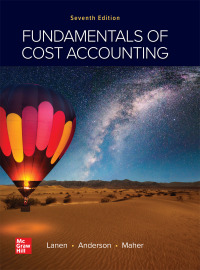Answered step by step
Verified Expert Solution
Question
1 Approved Answer
Case Study: Decision Analysis MAKE OR BUY: MANUFACTURE OR OUTSOURCE? Since the beginning of COVID and the initial stay-at-home orders, demand has skyrocketed for at


Case Study: Decision Analysis MAKE OR BUY: MANUFACTURE OR OUTSOURCE? Since the beginning of COVID and the initial stay-at-home orders, demand has skyrocketed for at home fitness equipment such as cycles designed to be used with interactive fitness platforms to bring the energy and benefits of studio-style workouts to the convenience and comfort of home. Cyclonic is a fitness platform that sells proprietary indoor exercise bikes For the past decade, Cyclonic has outsourced their manufacturing process to a contract manufacturer in Taiwan. Given their global supply chain that Cyclonic has developed, they are considering if they should vertically integrate into manufacturing and produce the bikes themselves In the spin bike industry, the trend has been to locate manufacturing facilities in low wage countries since the labor content to produce the finished product is significant. As a result, Cyclonic is considering setting up their own in-house production facility in Vietnam However, they are not ruling out the option to continue to outsource manufacturing (in Taiwan), Given their current supplier in Taiwan, they would not need to pay any fixed cost but would have to guarantee to purchase 55K units for $1100 each. If they decided to produce the cycles themselves in Vietnam, they would have an estimated fixed cost of approximately $18 million dollars including mortgage, machinery, overhead and fixed labor costs. The unit cost to manufacture each cycle would be $825. The selling price of the Cyclonic cycles would be $1995 each. Their main concern is the demand. If demand is strong, the number of bikes they can sell is uniformly distributed between 45K and 75K. If demand is weak, the number of bikes they can sell is uniformly distributed between 20K and 50K There is a 60% chance that demand will be strong. If Cyclonic chooses to continue to outsource and the demand is greater than the 55K, they can only sell the 55K units that they purchased. If demand is less than the 55K units, they will only earn revenue on the amount demanded even though they must purchase the full 55K units from their vendor If Cyclonic chooses to manufacture the bikes themselves, they can produce an initial 30K bikes and then will have the option to run a second production run of anywhere between 0 and 45K additional exercise bikes in response to market conditions. The timing of the second production run would be shortly after Cyclonic would know with certainty if the market will be weak or strong. Thus, the total quantity that Cyclonic can produce will vary between 30K and 75K bikes - that's a 30K minimum from the first production run plus anywhere from 0 to 45K units for the second run Once again, given that demand varies, if Cyclonic produces more cycles than the demand, it will only be able to collect revenue from the cycles sold and if the demand is greater than the number of cycles produced (after the second production run), Cyclonic can only sell the number of cycles produced (app" your findings and recommendations. Be sure to include the 1. (10 points) Case Synopsis (include a brief summary of the case and the business issue(s) being studied) 2. (50 points) Methodology (including a discussion of what information was provided and how you used this information to analyze the problem) (a) Organize the available data on cost, revenue, and probability estimates in a table. (b) Set up a decision tree to model the scenario presented to Cyclonic. I want to see two versions of your decision tree. i. First, show the tree with the algebraic formulations as your payoffs before you run the simulations - see the examples in the lecture notes (eg. from FOOZ lecture example = $250*MIN(D, Q) - $150000 - $1300) ii. Second (completed after step (c)), after running simulations and optimization, show the decision tree with your payoffs (average profit calculated from the four simulations). Show your solved decision tree. (c) Use simulation to estimate the expected profit generated for each option under both weak and strong demand scenarios. HINT: for the simulations, use 500 samples each. You will have four worksheets with simulations - OUTSOURCE-WEAK; OUTSOURCE-STRONG; MANUFACTURE-WEAK; MANUFACTURE-STRONG) For the manufacturing option, use Optimization to calculate the optimal number of spin bikes to produce for both the weak and strong demand scenarios. 1 IMPORTANT NOTES: (1) You may either draw out the decision trees using the drawing tools in Word/PPT or you may use TreePlan to enter the problem into Excel. Be sure to differentiate between Decision Nodes and Chance nodes and label all branches. (2) Each of your simulations should be on separate Excel worksheets. All worksheets should be in one Excel file with clearly laheled tahs to generate your simulations use the Random Number Case Study: Decision Analysis MAKE OR BUY: MANUFACTURE OR OUTSOURCE? Since the beginning of COVID and the initial stay-at-home orders, demand has skyrocketed for at home fitness equipment such as cycles designed to be used with interactive fitness platforms to bring the energy and benefits of studio-style workouts to the convenience and comfort of home. Cyclonic is a fitness platform that sells proprietary indoor exercise bikes For the past decade, Cyclonic has outsourced their manufacturing process to a contract manufacturer in Taiwan. Given their global supply chain that Cyclonic has developed, they are considering if they should vertically integrate into manufacturing and produce the bikes themselves In the spin bike industry, the trend has been to locate manufacturing facilities in low wage countries since the labor content to produce the finished product is significant. As a result, Cyclonic is considering setting up their own in-house production facility in Vietnam However, they are not ruling out the option to continue to outsource manufacturing (in Taiwan), Given their current supplier in Taiwan, they would not need to pay any fixed cost but would have to guarantee to purchase 55K units for $1100 each. If they decided to produce the cycles themselves in Vietnam, they would have an estimated fixed cost of approximately $18 million dollars including mortgage, machinery, overhead and fixed labor costs. The unit cost to manufacture each cycle would be $825. The selling price of the Cyclonic cycles would be $1995 each. Their main concern is the demand. If demand is strong, the number of bikes they can sell is uniformly distributed between 45K and 75K. If demand is weak, the number of bikes they can sell is uniformly distributed between 20K and 50K There is a 60% chance that demand will be strong. If Cyclonic chooses to continue to outsource and the demand is greater than the 55K, they can only sell the 55K units that they purchased. If demand is less than the 55K units, they will only earn revenue on the amount demanded even though they must purchase the full 55K units from their vendor If Cyclonic chooses to manufacture the bikes themselves, they can produce an initial 30K bikes and then will have the option to run a second production run of anywhere between 0 and 45K additional exercise bikes in response to market conditions. The timing of the second production run would be shortly after Cyclonic would know with certainty if the market will be weak or strong. Thus, the total quantity that Cyclonic can produce will vary between 30K and 75K bikes - that's a 30K minimum from the first production run plus anywhere from 0 to 45K units for the second run Once again, given that demand varies, if Cyclonic produces more cycles than the demand, it will only be able to collect revenue from the cycles sold and if the demand is greater than the number of cycles produced (after the second production run), Cyclonic can only sell the number of cycles produced (app" your findings and recommendations. Be sure to include the 1. (10 points) Case Synopsis (include a brief summary of the case and the business issue(s) being studied) 2. (50 points) Methodology (including a discussion of what information was provided and how you used this information to analyze the problem) (a) Organize the available data on cost, revenue, and probability estimates in a table. (b) Set up a decision tree to model the scenario presented to Cyclonic. I want to see two versions of your decision tree. i. First, show the tree with the algebraic formulations as your payoffs before you run the simulations - see the examples in the lecture notes (eg. from FOOZ lecture example = $250*MIN(D, Q) - $150000 - $1300) ii. Second (completed after step (c)), after running simulations and optimization, show the decision tree with your payoffs (average profit calculated from the four simulations). Show your solved decision tree. (c) Use simulation to estimate the expected profit generated for each option under both weak and strong demand scenarios. HINT: for the simulations, use 500 samples each. You will have four worksheets with simulations - OUTSOURCE-WEAK; OUTSOURCE-STRONG; MANUFACTURE-WEAK; MANUFACTURE-STRONG) For the manufacturing option, use Optimization to calculate the optimal number of spin bikes to produce for both the weak and strong demand scenarios. 1 IMPORTANT NOTES: (1) You may either draw out the decision trees using the drawing tools in Word/PPT or you may use TreePlan to enter the problem into Excel. Be sure to differentiate between Decision Nodes and Chance nodes and label all branches. (2) Each of your simulations should be on separate Excel worksheets. All worksheets should be in one Excel file with clearly laheled tahs to generate your simulations use the Random Number
Step by Step Solution
There are 3 Steps involved in it
Step: 1

Get Instant Access to Expert-Tailored Solutions
See step-by-step solutions with expert insights and AI powered tools for academic success
Step: 2

Step: 3

Ace Your Homework with AI
Get the answers you need in no time with our AI-driven, step-by-step assistance
Get Started


